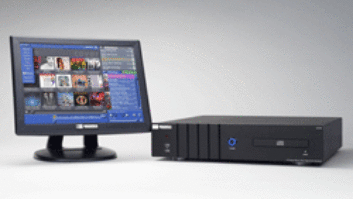Q205 Music Management System

What really sets the Qsonix Q205 apart is its terrific interface and user experience.
Without a doubt, Apple “i-stuff” works great. It’s easy to use, it’s handy, and I’d never travel without mine. But, at home listening to my “good rig,” I want an option for a better experience than what iPod or iTunes supplies. And swaying a music-loving client away from an i-based music solution shouldn’t be too difficult. You just need a product that has a compelling GUI, terrifically manages their music, and sounds better.
One product worthy of consideration is the Qsonix Q205 High Performance Digital Music Management System. While the Qsonix name may be new to you, it has been around since 2004. The Q205 was built with top-shelf audio as the core design goal and features an entirely new digital audio section handled by Wadia Digital, a company whose name is practically synonymous with audiophile-grade sound. That’s akin to buying a car with an “engine by Ferrari” badge.
The Q205 comes in a variety of trims–15, 17, or 19-inch touchpanel with 1 or 2TB of storage– ranging from $7450 to $8150. The server chassis features an audiophile-esque black design with milled aluminum faceplate. It has a single glowing blue ring (sadly undefeatable; that blue Cyclops stared at me through many movies!) indicating power. The touchpanel looks decidedly less elegant, appearing much like a plastic framed desktop PC monitor. A variety of RapidRun cable connections are available to connect the two components if the gear is racked elsewhere.
Qsonix provides enough digital connections–all capable of outputting high-resolution audio files up to 24-bit/192kHz–to accommodate any install. The system also supports a separate “zone” USB digital output (24-bit/96/kHz), which is useful if a client is integrating with one of the growing number of high-performance, outboard DACs, such as the impressive PS Audio PerfectWave, reviewed previously by Dennis Burger.
There are a variety of configuration options such as setting cross fade and soft fade durations, import options (WAV, FLAC or compressed), network paths for importing music files, GUI color, etc. These are all easily recalled if a client wants to get in and tinker. One brilliant feature is that nearly every option has a large yellow “?” next to it, ready to explain what something does. Clients no longer need to search through the manual or call you. They just tap the screen and keep enjoying. That is so slick!
Not to gloss over the audio performance– which was terrific, and everything you’d expect from Wadia Digital–but what really sets the Q205 apart is its terrific interface and user experience, so I’m going to devote the majority of the review to that. Suffice it to say, the server was silent in operation and audio was detailed and impressive. Whether playing WAV, FLAC, high-res, or MP3 files, the Q205 always delivered a stellar musical experience that will be at home in a system of any price.

The “managed playlist menu” within the user interface of the new Qsonix Q205 System.
While touchscreens certainly aren’t new, they definitely create a physical connection between the user and their collection. Additionally, the Qsonix interface adds another layer with its unique drag-and-drop capabilities. And if your clients have used a computer, then this interface will be instantly intuitive to them. Browsing is done in a large variety of manners, including via album art, artist, year, genre, etc. See a song you like–or album, or artist or genre, year or decade–then drag it into the now playing list. (A Web control option is available, but currently lacks the panache of the touchpanel experience. Qsonix president, Mike Weaver said that along with a new killer iPad app to replicate the touchpad experience, his company plans to add Internet Radio and NAS storage support.) Another brilliant feature is the ability to double-tap a title and preview a snippet of a song. How many times have you been putting a play list together and you’re looking to add music and you’re thinking, “Is that the song I want?” Wonder no more.
The Q205 is a CD ripping dynamo, blasting through discs in around three minutes. Like any modern music server, it grabs all the pertinent artist, album, track titles and cover art metadata. But it goes further, pulling album reviews and a deeper level of information such as composers in the classical genre. Qsonix also taps into AMG’s Tapestry, a Pandora-like feature that scrutinizes your music collection on a track-by-track basis. If iTunes is “Genius” then this has Einstein and Hawking lovechild level smarts. Beyond merely picking a song and pressing “Play Similar,” you can create focused playlists of exactly the type and style of music you’re in the mood for. By mixing and combing themes, tones styles/ genres, the Q205 was the perfect personal DJ, mining my collection to find exactly the kind of music I was in the mood for. Further, a handy search feature enables users to find exactly what they’re looking for, regardless of collection size.
The Q205 is about reconnecting with a music collection, and its unique GUI creates a powerful and wonderful user experience, finding exactly what you want even when you aren’t sure what that is. Plus, the digital audio output is above reproach. I have auditioned many music servers, but the Qsonix experience stands out as one of the best.
877.477.6649
www.qsonsix.com
Kudos
Terrific user interface, onscreen help, the ability to always find exactly the right kind of music and digital goodness powered by Wadia Digital all add up to a sweet package.
Concerns
Currently lacks any Web-based music options; touchpanel lacks high-end fit and finish.
Product Specs
■ Handles MP3, WMA (including lossless up to 24/192k), AAC (including lossless), FLAC (up to 24/192k), WAV, AIFF file formats
■ AMG metadata including Tapestry
■ RS-232 and TCP/ IP control protocol support for automation integration
■ Supports a second, discrete output zone via USB DAC
■ Connections: 2 coaxial digital (RCA and BNC ), 1 balanced AES /EBU, 1 Toslink optical, 5 USB (4 rear, 1 front), DVI, VGA, 2 DB9 serial, 1 Gigabit Ethernet



